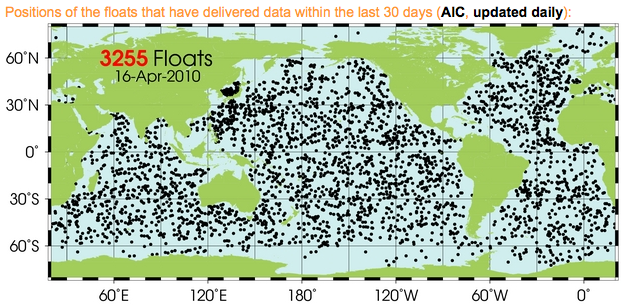
Position of ARGO floats as of 4/16/10, courtesy the University of California San Diego.
A new study (pdf) shows a warming globe is intensifying Earth’s water cycle, making arid regions drier and high rainfall regions wetter. It also finds a clear link between warming-driven salinity changes at the ocean’s surface and changes underwater that match the pathways surface waters take into the deep ocean.
The changes in the water cycle mean that the ocean beneath rainy regions of the globe has freshened, while the ocean in areas dominated by evaporation have grown saltier. The paper also confirms that surface warming of the world’s oceans over the past 50 years has penetrated into the oceans’ interior, changing deep-ocean salinity patterns.
Salinity affects the speed, direction, and depth of ocean currents.
The ocean’s average surface temperature has risen nearly a degree Fahrenheit since 1950.
Lead author Paul Durack at the joint CSIRO/University of Tasmania, Quantitative Marine Science program tells CSIRO:
“This is further confirmation from the global ocean that the Earth’s water cycle has accelerated. These broad-scale patterns of change are qualitatively consistent with simulations reported by the Intergovernmental Panel on Climate Change (IPCC). While such changes in salinity would be expected at the ocean surface—where about 80 per cent of surface water exchange occurs—sub-surface measurements indicate much broader, warming-driven changes are extending into the deep ocean.”
The data for this study come from historical records and from Argo‘s world-wide network of ocean profilers—robotic submersible buoys that record and report ocean salinity levels and temperatures to depths of 1.2 miles.
“Fifty-year trends in global ocean salinities and their relationship to broad-scale warming” is to be published in the American Meteorological Society’s Journal of Climate.















